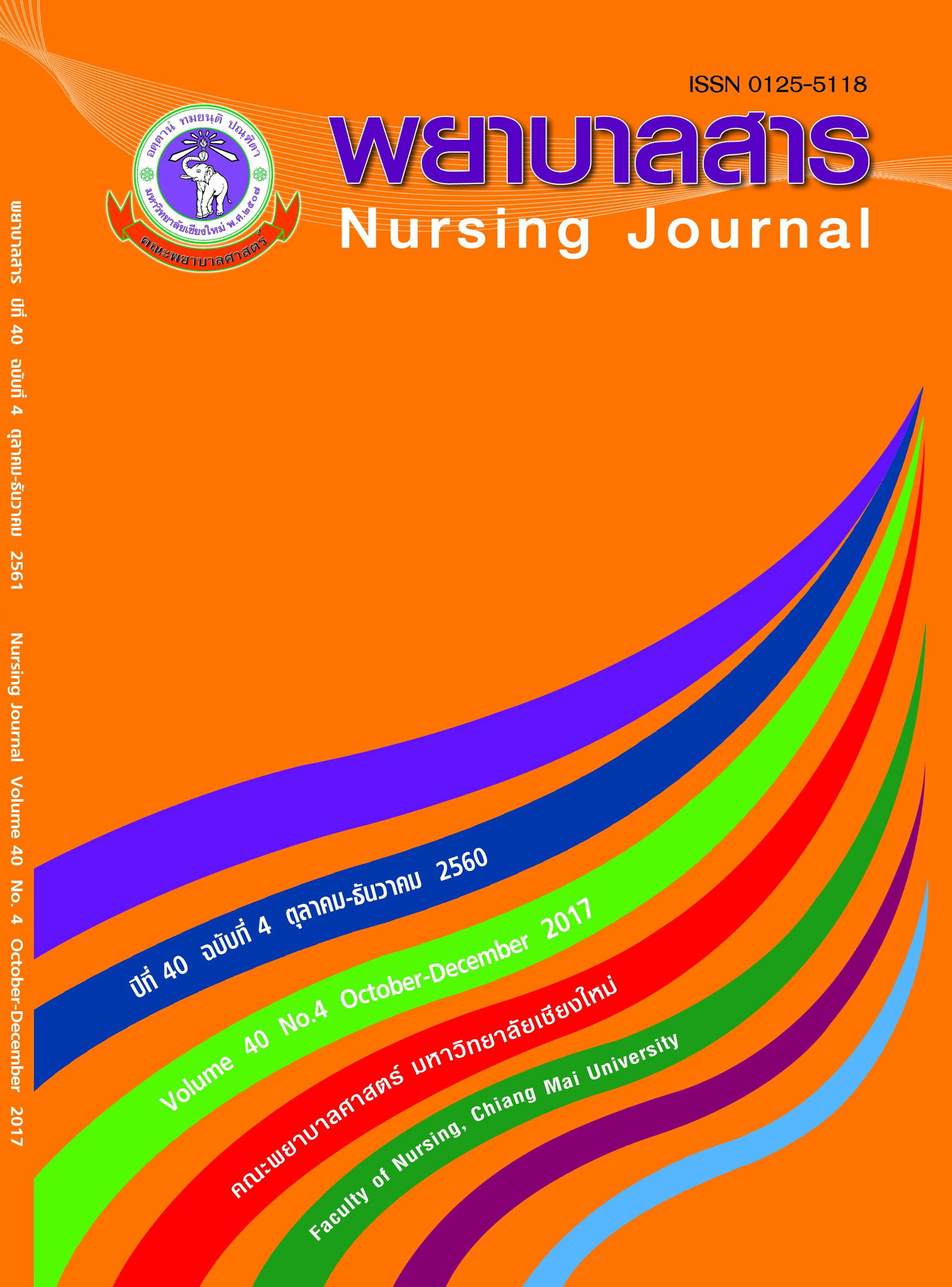Predicting Factors of Readiness for Hospital Discharge among Older Patients with Acute Myocardial Infarction
Keywords:
Older patient with acute myocardial infarction, readiness for hospital discharge, hospitalization experience, quality of discharge teaching, care coordination before dischargeAbstract
Readiness for hospital discharge in older persons with acute myocardial infarction is important for providing safe and continuous care. The purposes of this correlational predictive study was to examine the factors predicting readiness for hospital discharge among older patients with acute myocardial infarction including gender, living arrangement, hospitalization experience, total quality of discharge teaching (including content received and nurses’ s teaching skill) and care coordination before discharge. The samples consisted of 100 older patients with acute myocardial infarction who were aged 60 to 80 years old and admitted to hospitals in Phang-Nga, Surat Thani, Trang, and Maharaj Nakhon Si Thammarat hospitals. Data were collected by using a readiness for hospital discharge scale, a quality of discharge teaching scale, and a care coordination before discharge scale. Data were analyzed using descriptive statistics, Phi correlation coefficient, Point biserial correlation coefficient, Pearson product-moment correlation coefficient, and enter multiple regression analysis.
The results of the study indicated that perceived readiness for hospital discharge and quality of discharge teaching were at a high level (=181.55, SD=13.62 and =151.05, SD=11.44).Care coordination before the discharge of older patients with acute myocardial infarction was at a good level (=111.83,SD=6.23). Nurses' teaching delivery skill was the main predictor that correlated with readiness for hospital discharge with a multiple correlation coefficient of .586. Otherwise, all predictive factors could predict the readiness for hospital discharge at 34.3% (R2=0.343, p<0.01).
The results of this study could be used as basic information for nurses and health personnel to prepare older patients with acute myocardial infarction to take care of themselves at home by improving both content and methods of teaching and coordinating care plans.
References
ณัฐวรรณ สุวรรณ และศิริรัตน์ ปานอุทัย. (2557). แบบสอบถามการประสานการดูแลก่อนจำหน่าย เครื่องมือการประสานการดูแลที่พัฒนาโดย เฮดจิสตาโวโพลอส และคณะ (Hadjistavropoulos, Biem, Sharpe, Bourgault-Fagnou & Janzen, 2008) ฉบับภาษาไทย เชียงใหม่: มหาวิทยาลัยเชียงใหม่.
ศรินรัตน์ ศรีประสงค์. (2551).การทดสอบเชิงประจักษ์รูปแบบจำลองการทำหน้าที่ในกิจวัตรประจำวันในผู้ป่วยกล้ามเนื้อหัวใจตายเฉียบพลันภายหลังออกจากโรงพยาบาล. (วิทยานิพนธ์ปรัชญาดุษฎีบัณฑิต สาขาวิชาการพยาบาล). บัณฑิตวิทยาลัย มหาวิทยาลัยมหิดล.
ศรินรัตน์ ศรีประสงค์, สมจิต หนุเจริญกุล, อรสา พันธุ์ภักดี, รุ่งโรจน์ กฤตยพงษ์,คนึงนิจ พงศ์ถาวรกมล, และธวัชชัย วรพงศธร. (2554). ปัจจัยส่วนบุคคลที่มีผลต่อการรับรู้ความพร้อมก่อนออกจากโรงพยาบาลของผู้ป่วยกล้ามเนื้อหัวใจตายเฉียบพลัน. วารสารพยาบาลโรคหัวใจและทรวงอก, 22(2), 44 –57.
ศิริรัตน์ ปานอุทัย. (2557). แบบประเมินคุณภาพการสอนก่อนจำหน่ายฉบับผู้ใหญ่ที่พัฒนาโดยไวส์ และเพียเซ็นไทย์ (Weiss & Piacentine, 2006) ฉบับภาษาไทย. เชียงใหม่: มหาวิทยาลัยเชียงใหม่.
สถาบันเวชศาสตร์ผู้สูงอายุ . (2544).คณะกรรมการจัดทำแบบทดสอบสภาพสมองเบื้องต้น ฉบับภาษาไทย พ.ศ. 2542. แบบทดสอบสภาพสมองเบื้องต้น ฉบับภาษาไทย MMSE-Thai 2002. กรมการแพทย์ กระทรวงสาธารณสุข.
แสงเดือน กันทะขู้, ดวงรัตน์ วัฒนกิจไกรเลิศ, คนึงนิจ พงศ์ถาวรกมล, และฉัตรกนก ทุมวิภาต. (2552). ปัจจัยที่มีอิทธิพลต่อความพร้อมก่อนจำหน่ายออกจากโรงพยาบาลในผู้ป่วยกล้ามเนื้อหัวใจตายเฉียบพลัน. Journal of Nursing Science, 21(2),83–91.
อรรถเกียรติ กาญจนพิบูลวงศ์, และคำนวณ อึ้งชูศักย์.(2557).รายงานการเฝ้าระวังโรคไม่ติดต่อเรื้อรัง ปีพ.ศ. 2557.รายงานการเฝ้าระวังทางระบาดวิทยาประจำสัปดาห์ 2557, 44(10), 145-152.สำนักระบาดวิทยา กรมควบคุมโรค กระทรวงสาธารณสุข.
Hadjistavropoulos, H., Biem, H., Sharpe, D., Bourgault-Fagnou, M., & Janzen, J. (2008). Patient perceptions of hospital discharge: reliability and validity of a patient continuity of care questionnaire. International Journal for Quality in Health Care, 20(5), 314-323.doi: 10.1093/intqhc/mzn030.
Meleis, A. I., Sawyer, L. M., Im, E. O., HilfingerMessias, D. K., & Schumacher, K. (2000). Experiencing transitions: an emerging middle-range theory. Advanced Nursing Science, 23(1), 12-28.
Mozaffarian, D., Benjamin, E. J., Go, A. S., Arnett, D. K., Blaha, M. J., Cushman, M., & Huffman, M. D. (2015). American heart association statistics committee and stroke statistics subcommittee.Heart disease and stroke statistics–2015 update: A report from the American Heart Association. Circulation, 131(4), e29-e322.
Smith, J., & Liles, C. (2007). Information needs before hospital discharge of myocardial infarction patients: a comparative, descriptive study. Journal of Clinical Nursing, 16(4), 662-671. doi: 10.1111/j.1365-2702.2006.01689.
Thorndike, R. M. (1978). Correlational procedure for research. New York: Gardner Press.
Weiss, M. E., & Piacentine, L. B. (2006).Psychometric properties of the readiness for hospital discharge scale.Journal of Nursing Measurement, 14(3), 163-180.
Weiss, M. E., Piacentine, L. B., Lokken, L., Ancona, J., Archer, J., Gresser, S., Vega-Stromberg, T. (2007). Perceived readiness for hospital discharge in adult medical-surgical patients. Clinical Nurse Specialist, 21(1), 31-42.
Downloads
Published
How to Cite
Issue
Section
License
บทความที่ได้รับการตีพิมพ์เป็นลิขสิทธิ์ของวารสารพยาบาลสาร
ข้อความที่ปรากฏในบทความแต่ละเรื่องในวารสารวิชาการเล่มนี้เป็นความคิดเห็นส่วนตัวของผู้เขียนแต่ละท่านไม่เกี่ยวข้องกับมหาวิทยาลัยเชียงใหม่ และคณาจารย์ท่านอื่นๆในมหาวิทยาลัยฯ แต่อย่างใด ความรับผิดชอบองค์ประกอบทั้งหมดของบทความแต่ละเรื่องเป็นของผู้เขียนแต่ละท่าน หากมีความผิดพลาดใด ๆ ผู้เขียนแต่ละท่านจะรับผิดชอบบทความของตนเองแต่ผู้เดียว






